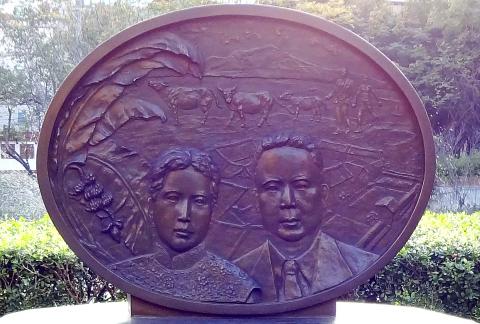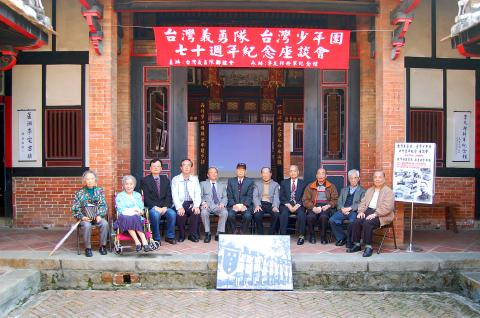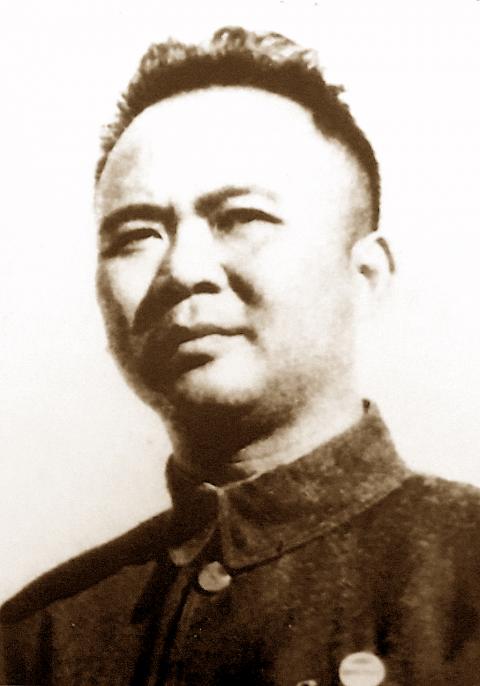Dec. 11 to Dec. 17
Lee You-pang (李友邦) thought his struggle was over when he returned to Taiwan in mid-December of 1945. After all, he had achieved his dream of helping free Taiwan from the grasp of the Japanese Empire and returning it to the “motherland” of China.
But more trouble lurked under the rule of the Chinese Nationalist Party (KMT), which assumed control of Taiwan when the Japan surrendered at the end of World War II. Three months after Lee’s return, governor-general Chen Yi (陳儀) disbanded Lee’s Taiwan Militia (台灣義勇隊) without discharge orders or pension, essentially hanging out to dry the group of men and women who had spent six years helping the Chinese fight the Japanese.

Photo courtesy of Wikimedia Commons
Lee was later jailed on charges of corroboration with the “communist bandits” and inciting rebellion during the 1947 anti-government uprising and subsequent brutal crackdown that would be known as the 228 Incident. His wife and comrade-in-arms, Yen Hsiu-feng (嚴秀峰), saved him that time, but she was in jail when he was taken away again in 1951 on charges of colluding with the Chinese Communists Party (CCP) to overthrow the government.
On April 22, 1952, Lee was executed by the regime he had hoped to support. He was 46. Yen was released from jail in 1965 and spent the next 50 years raising five children, trying to clear her husband’s name and preserving the historic Lee home in New Taipei City’s Lujhou District (蘆洲), which is today open to the public.
“Lee You-pang should have died on the battlefield,” Yen is known to often have said. “Instead, he died in his beloved homeland for which he gave his all.”

Photo: Wu Chia-yi, Taipei Times
But she adds that she would not hesitate to do it all over again.
ETERNAL REBEL
Lee was a wanted man by the time he was 18 years old, having led student attacks on Japanese police stations in 1922 and 1924. Anti-Japanese sentiment among students was high during that period, especially with the 1921 establishment of the Taiwan Cultural Association (台灣文化協會), which aimed to passively counter Japanese rule by fostering an awareness of Taiwanese nationalism.

Photo courtesy of Wikimedia Commons
Narrowly dodging arrest, Lee fled to China where he enrolled in the the newly-established Whampoa Military Academy (黃埔軍校) and joined the KMT. During this time he formed the Taiwan Independence Revolutionary Party (臺灣獨立革命黨) — but under this context he meant independence from Japan so Taiwan could return to Chinese rule.
He spent the next few years organizing anti-Japanese activities among Taiwanese living in China, and eventually spent time in Tokyo under the guise of a Waseda University student, networking with local revolutionaries.
Lee’s group was disbanded during new KMT leader Chiang Kai-shek’s (蔣介石) communist purge in 1927 as it was deemed to have leftist leanings. Having nobody else to turn to and with the Japanese on his tail, Lee joined the Communist Youth League of China (中國共產主義青年團) and started teaching Japanese in Hangzhou.

Photo: CNA
In 1932, he was arrested by the KMT and subjected to heavy torture. By the time he was released in 1934, both his younger brothers, also revolutionaries, were killed by the Japanese.
The Sino-Japanese War broke out in 1937, upon which Lee immediately revived his party. In 1938, he formed the Taiwan Militia with the help of the Communists and the approval of the KMT, who were working together against a common enemy.
The following is an excerpt from Lee’s recruitment speech: “Now our great motherland has raised the banner and is resisting the Japanese. This sacred battle has been going on for more than a year now, and this is the perfect chance for us Taiwanese to liberate ourselves. My dear compatriots, how can we continue to watch from the sidelines? How can we bypass this chance to fight with the motherland to defeat our hated enemy for the past 40 years?”
NO PLACE FOR LOVE IN WAR
Around the same time, a 17-year-old Yen left Hangzhou for the battlefield. The only child of a well-to-do family, she begged her father relentlessly for five months before he let her go to war. She showed her bravery with a daring run across the frontlines to deliver secret documents to another camp, spending the last two hours crawling through bushes in the mountains.
Lee and Yen met on the frontlines, and they started spending time together as he offered her Japanese lessons. She turned him down when he proposed, telling him there’s no place for love in war. But Lee was persistent. The pair married in 1941, and she started working for the Taiwan Militia.
The militia’s main tasks were medical support, propaganda and production, but it also saw action, including several raids into Japanese-ruled Xiamen, where they snuck in and put up anti-Japanese posters. It also made use of its members’ knowledge of Japanese to carry out various rescue and reconnaissance missions.
Lee welcomed Taiwanese of all walks of life into his group, including many Communists. This drew the attention of the KMT, which Yen says sealed his fate.
Back in Taiwan, Lee ran the Taiwan branch of the Three Principles Youth Group (三民主義青年團), while Yen helped out and offered Mandarin lessons. When the 228 Incident broke out, Chen asked Lee to broadcast a plea for the people to stop resisting, but Lee refused and criticized Chen for corruption and misrule. Soon, he was arrested and sent to Nanjing.
A pregnant Yen traveled to Nanjing and somehow managed to get an audience with Chiang Kai-shek’s son, Chiang Ching-kuo (蔣經國), who suspected that Lee incited the uprising. Lee was eventually let go and returned to Taiwan to great fanfare.
In 1950, Yen was sentenced to 15 years in jail for meeting a suspected Communist. This time she was unable to save Lee.
EPILOGUE
It was around dusk on Aug. 15, 1945 when Lee and Yen heard the news. A local reporter had run into his house, yelling: “They’ve surrendered!”
Lee and Yen couldn’t believe it. “Who announced it?” they asked.
“We received word from the Americans,” the reporter said.
They jumped up at the same time and hugged each other, fighting back tears. “We’ve won,” Lee shouted as they left their dinner unfinished and ran outside to spread the word.
Taiwan in Time, a column about Taiwan’s history that is published every Sunday, spotlights important or interesting events around the nation that have anniversaries this week.

Most heroes are remembered for the battles they fought. Taiwan’s Black Bat Squadron is remembered for flying into Chinese airspace 838 times between 1953 and 1967, and for the 148 men whose sacrifice bought the intelligence that kept Taiwan secure. Two-thirds of the squadron died carrying out missions most people wouldn’t learn about for another 40 years. The squadron lost 15 aircraft and 148 crew members over those 14 years, making it the deadliest unit in Taiwan’s military history by casualty rate. They flew at night, often at low altitudes, straight into some of the most heavily defended airspace in Asia.

Beijing’s ironic, abusive tantrums aimed at Japan since Japanese Prime Minister Sanae Takaichi publicly stated that a Taiwan contingency would be an existential crisis for Japan, have revealed for all the world to see that the People’s Republic of China (PRC) lusts after Okinawa. We all owe Takaichi a debt of thanks for getting the PRC to make that public. The PRC and its netizens, taking their cue from the Chinese Communist Party (CCP), are presenting Okinawa by mirroring the claims about Taiwan. Official PRC propaganda organs began to wax lyrical about Okinawa’s “unsettled status” beginning last month. A Global

Taiwan’s democracy is at risk. Be very alarmed. This is not a drill. The current constitutional crisis progressed slowly, then suddenly. Political tensions, partisan hostility and emotions are all running high right when cool heads and calm negotiation are most needed. Oxford defines brinkmanship as: “The art or practice of pursuing a dangerous policy to the limits of safety before stopping, especially in politics.” It says the term comes from a quote from a 1956 Cold War interview with then-American Secretary of State John Foster Dulles, when he said: ‘The ability to get to the verge without getting into the war is

Like much in the world today, theater has experienced major disruptions over the six years since COVID-19. The pandemic, the war in Ukraine and social media have created a new normal of geopolitical and information uncertainty, and the performing arts are not immune to these effects. “Ten years ago people wanted to come to the theater to engage with important issues, but now the Internet allows them to engage with those issues powerfully and immediately,” said Faith Tan, programming director of the Esplanade in Singapore, speaking last week in Japan. “One reaction to unpredictability has been a renewed emphasis on